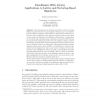Free Online Productivity Tools
i2Speak
i2Symbol
i2OCR
iTex2Img
iWeb2Print
iWeb2Shot
i2Type
iPdf2Split
iPdf2Merge
i2Bopomofo
i2Arabic
i2Style
i2Image
i2PDF
iLatex2Rtf
Sci2ools
113
click to vote
ASIACRYPT
2009
Springer
2009
Springer
Fiat-Shamir with Aborts: Applications to Lattice and Factoring-Based Signatures
We demonstrate how the framework that is used for creating efficient number-theoretic ID and signature schemes can be transferred into the setting of lattices. This results in constructions of the most efficient to-date identification and signature schemes with security based on the worst-case hardness of problems in ideal lattices. In particular, our ID scheme has communication complexity of around 65, 000 bits and the length of the signatures produced by our signature scheme is about 50, 000 bits. All prior lattice-based identification schemes required on the order of millions of bits to be transferred, while all previous lattice-based signature schemes were either stateful, too inefficient, or produced signatures whose lengths were also on the order of millions of bits. The security of our identification scheme is based on the hardness of finding the approximate shortest vector to within a factor of ˜O(n2 ) in the standard model, while the security of the signature scheme is b...
ASIACRYPT 2009 | Cryptology | Identification Scheme | Lattice-based Signature Schemes | Signature Scheme |
| Added | 25 May 2010 |
| Updated | 25 May 2010 |
| Type | Conference |
| Year | 2009 |
| Where | ASIACRYPT |
| Authors | Vadim Lyubashevsky |
Comments (0)

